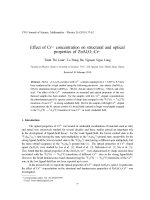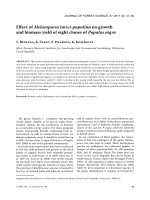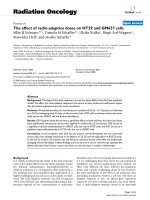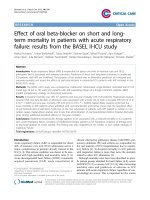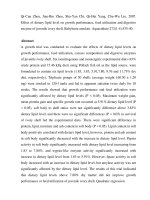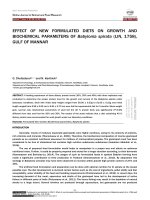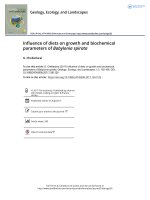Effect of new formulated diets on growth and b
Bạn đang xem bản rút gọn của tài liệu. Xem và tải ngay bản đầy đủ của tài liệu tại đây (152.37 KB, 6 trang )
2017 Scienceline Publication
Online Journal of Animal and Feed Research
Volume 7, Issue 4: 91-96; Jul 25, 2017
ISSN 2228-7701
EFFECT OF NEW FORMULATED DIETS ON GROWTH AND
BIOCHEMICAL PARAMETERS OF Babylonia spirata (LIN, 1758),
GULF OF MANNAR
G. Chelladurai1 and N. Karthick2
1Department
of Zoology, G.Venkataswamy Naidu, Kovilpatti, Tuticorin, TamilNadu, India
of Plant Botany and Plant Biotechnology, G.Venkataswamy Naidu, Kovilpatti, Tuticorin, TamilNadu, India
Email:
2Department
ABSTRACT: A feeding experiment of three dietary protein levels (30%, 35% and 40%) with three replicates was
length ranged from 5.96 ± 0.62 cm to 6.91 ± 0.70 cm were fed the experimental diet for 3 months. Mean weight
gain, survival rate, biochemical parameters of snail fed the 40 % protein diets was significantly (P<0.05)
different from that snail fed the 30% and 35%. The results of the study indicate that a diet containing 40 %
dietary protein was recommended for snail growth under our laboratory conditions.
ORIGINAL ARTICLE
laboratory conditions. Snail with initial body weight ranged from 50.95 ± 0.33g to 51.05 ± 0.21g and initial
pii: S222877011700015-7
Received 18 Jun. 2017
Accepted 20 Jul. 2017
conducted to determine the proper protein level for the growth and survival of the Babylonia spirata under
Keywords: Formulated diet, Growth, Biochemical parameters, Babylonia spirata
INTRODUCTION
Generally, meats of molluscs especially gastropods were highly nutritious, owing to its contents of proteins,
rich vitamins and minerals (Thanonkaew et al., 2006). Therefore, the biochemical composition of marine gastropod
persists as an excellent nutritional assurance for millions of malnourished peoples. The gastropod meat has been
considered to be free of cholesterol but contains high nutritive substances substances (Asadatun Abdullah et al.,
2016).
The use of prepared feed formulation would helps to manipulate in a proper way and obtain an optimum
nutritional value. Further, it could be properly prepared and stored for a longer duration according, to their demands
(Nyameasem and Borketey-La, 2014). The usages of such as formulated feeds in spotted Babylon farming have
made a significant contribution to their production in Thailand (Chaitanawisuti et al., 2010). By adaptation this
strategy in Babylonia areolata may have been observed to increase within growth high protein content of 27% and
45%.
The artificial feed formulation and preparation can be done with optimal nutrition for B. spirata at the lowest
possible cost. The diet development is involved certain factors such as the cost of ingredients, pellet ability and diet
acceptability, water stability of the feed and handling requirements (Chaitanawisuti et al., 2010). In recent days, the
increasing demand of the meat, operculum and shells of the gastropod have led to the development of active
fishery in different parts of India (Periyasamy et al., 2011). The heavy fishing may result in the depletion of natural
stocks to a large extent. Several bivalves are produced through aquaculture, but gastropods are not produced
91
To cite this paper: Chelladurai G. and Karthick N. (2017). Effect of new formulated diets on growth and biochemical parameters of Babylonia spirata (Lin, 1758), gulf
of Mannar. Online J. Anim. Feed Res., 7(4): 91-96.
Scienceline/Journal homepages: www.science-line.com; www.ojafr.ir
through aquaculture and they can also be cultured for commercial production. Only a few studies were done in
India on breeding, larval rearing and sea ranching of gastropods (Mohanraj et al., 2010). The present study deals
with the work, influence of formulated diets on growth and biochemical parameters of B. spirata.
Materials and Methods
The samples of B. spirata with their initial weight ranged from50.68g to 52.52g and initial length ranged
from 5.53cm to 5.82cmwere collected at the Therespuram coastal area (80 0 48’N; 780 94’ E), Tuticorin, Southeast
coast of India. Collected samples were made to acclimatize in 7 days in by using aerated plastic holding tanks
(1.5m×2m×0.5m L: W: H) in the Marine Gastropod Hatchery Research Laboratory, Kamaraj College, Tuticorin, Tamil
Nadu, India. During this study period, the snails were fed with natural live clam meat. Then they were randomly
distributed into triplicate FRP tank containing 200L at 40 snail /tank and three experimental groups were
maintained. The tanks were regularly cleaned, disinfected and allowed to dry for 24h after which they were filled
with dechlorinated ambient seawater to 2/3 sizes of the tanks. The bottom of the rearing tanks was covered with 3
cm layer of coarse sand (500 to 1000 micron mean grain size) as substrate. After removing the snails from culture
tanks, sand was cleaned using a water jet flushing and sundried at 30days intervals in order to remove the
accumulated waste materials. During this period the snails were fed with formulated (30%, 35% and 40 % crude
protein) at once day. The total experiment was conducted for 90 days.
Experimental diet
The procedures for feed preparation were modified by Hardy (1980). The feed ingredients were homogenized
thoroughly in a food mixer. After adding distilled water to the mixed ingredients, a paste was made using a hand
mixer. The paste was shaped into 0.5 mm thick sheets and they were cut into 2 cm 2 flakes, sealed in a plastic bag
and stored at -200C. The experimental diets were formulated with the composition protein of 30%, 35% and 40%.
The fish meal and groundnut oil cake serves the protein source, fish oil as serves lipid source, tapioca powder
serves as the carbohydrate source, wheat flour serves as a binder and vitamin and mineral mixtures were also
added (Table 1).
Table 1 - Composition of basal diet
Ingredients
Fish Meal
Groundnut oil cake
Tapioca
Maida
Cod liver oil
Vitamin and Minerals mix
Proximate Composition
Moisture
Protein
Carbohydrate
Fat
Ash
abc
30%
35%
40%
26
26
23
23
1
1
32
32
17
17
1
1
38
38
11
11
1
1
30%
35%
0.26a
74.26 ±
30.45 ± 0.47b
10.87 ± 0.96c
2.16 ± 0.44d
8.11 ± 0.78e
0.78b
74.96 ±
34.63 ± 0.19b
10.96 ± 0.46ac
2.20 ± 0.63b
8.13 ± 0.75bc
40%
75.12 ± 0.15a
39.17 ± 0.31a
11.05 ± 0.24c
2.54 ± 0.10c
8.23 ± 0.84c
(Mean±SD) the same letter in the same row is not significantly different at P<0.05.
Water quality
The seawater quality parameter was analyzed weekly for its purity. It includes parameters like, temperature
(0C), salinity (ppt), pH and dissolved oxygen (mg/L) were examined by using SYSTRONICS water analyzer 371.
Growth parameters
The growth performance and biochemical profile were expressed in terms of weight measurements like
weight gain (g) and survival (%) were monitored according following formula of Chaitananawisuti et al. (2011).
Weight gain (g)
Final weight –Initial weight
Survival (%)
F2 × 100
F1
F1 - Number of snail at the being of experiment
F2 -Number of snail at the end of the experiment
92
To cite this paper: Chelladurai G. and Karthick N. (2017). Effect of new formulated diets on growth and biochemical parameters of Babylonia spirata (Lin, 1758), gulf
of Mannar. Online J. Anim. Feed Res., 7(4): 91-96.
Scienceline/Journal homepages: www.science-line.com; www.ojafr.ir
Estimation of Biochemical profile
The Folin- Ciocallteu phenol method of Lowry et al. (1951) was adopted for the estimation of total protein in
the tissue. Total carbohydrate content method was followed by Dubois et al. (1956). The lipid content was
estimated gravimetrically by following the method of Floch et al. (1956). The moisture and ash content was
followed by AOAC (1990).
Statistical analysis
All experimental data obtained were analyzed using one-way analysis of variance (ANOVA) followed by
Duncan’s multiple range test P < 0.05 was considered for describing the significant level (SPSS Version 20).
Results and Discussion
The aquaculture of molluscs seems to be seriously affected worldwide by bacterial pathogens and predators’
that cause high losses in hatcheries as well as in natural beds. The main responsible for the mortality outbreaks is
a number of Vibriosp and Aeromonas species that are considered important pathogens in aquaculture (Chen et al.,
2005). The pathologies caused by Vibrio in bivalves and gastropods have been described since the 1960s; however,
over recent years successive episodes of high mortality have been recorded due to these microorganisms. The
average shell length and weight and survival rate of B.spirata fed with formulated diet for three month are shown in
Table 2. The growth expressed as body weight, shell length and survival rate were significantly not different p<0.05
among the experiment diets. Among the average body weight gain, the highest was observed at 40% level of
protein diet (2.14 ± 0.84g) and the lowest was observed at 30% level of protein diet (1.01 ± 0.36g). In average final
shell length, the highest was observed at 40% diet (6.91± 0.70cm) and the lowest was observed at 30% diet (5.96
± 0.62cm). The average survival rate, the highest was observed at 40% of protein diet (91 ± 1.04%) and the lowest
was observed at 30% diet (89 ± 1.06%). The maximum growth and survival rate were observed in 40% protein diet.
Table 2 - Average length, weight and survival rate of B. spirata fed with (30%, 35% and 40%) different formulated
diet for 3 month
Diets
Initial weight
(g)
Final weight
(g)
Weight gain
(g)
Initial length
(cm)
Final length
(cm)
Survival
(%)
30%
50.95 ± 0.33a
51.96 ± 0.32ba
1.01 ± 0.36ca
5.56 ± 0.63a
5.96 ± 0.62b,a
89 ± 1.06ca
35%
50.16 ± 0.12ab
51.63 ± 0.15b
1.47 ± 0.55c
5.79 ± 0.45ab
6.59 ± 0.45b
90 ± 1.23cb
40%
51.05 ± 0.21a
53.45 ± 0.24b
2.14 ± 0.84cab
5.81 ± 0.41a
6.91 ± 0.70ba
91 ± 1.04c,a
Table 3 - Proximate composition of formulated deitof B. spirata
Proximate composition (%)
30%
35%
40%
Moisture
74.53 ± 0.06bac
74.31 ± 0.19c
80.17 ± 0.19a
Protein
46.12 ± 0.57bca
37.68 ± 0.55c
50.61 ± 0.61a
Carbohydrate
13.22 ± 0.74bac
11.92 ± 0.17c
15.41 ± 0.84ac
lipid
4.02 ± 0.03bac
3.80 ± 0.02c
4.09 ± 0.03ac
Ash
16.33 ± 1.15bac
13.33 ± 1.52cac
15.66 ± 0.57a
abc
(Mean±SD) the same letter in the same row is not significantly different at P<0.05.
93
To cite this paper: Chelladurai G. and Karthick N. (2017). Effect of new formulated diets on growth and biochemical parameters of Babylonia spirata (Lin, 1758), gulf
of Mannar. Online J. Anim. Feed Res., 7(4): 91-96.
Scienceline/Journal homepages: www.science-line.com; www.ojafr.ir
Table 3 - Average water quality parameters observed during experimental period of (12 weeks) in B. spirata at 30%,
35% and 40% of basal diet.
abcd
Weeks
1
2
3
4
5
6
7
8
9
10
11
12
Temperature (oC)
26.32±0.74a
26.90±0.98ab
27.12 ±0.30a
27.00 ±0.94a
27.96±0.73abc
26.85±0.86a
27.12±0.81a
26.08±0.37a
27.03±0.44ac
26.97±0.42a
27.06±0.83a
26.05±0.50a
Weeks
1
2
3
4
5
6
7
8
9
10
11
12
Temperature (oC)
26.55±0.17a
27.80±0.12a
26.18±0.29a
26.25±0.52a
27.49±0.69a
28.15±0.19a
26.92±0.29a
27.18±0.29ab
27.03±0.64ac
27.67±0.62ac
27.11±0.43a
26.85± 0.63a
Weeks
1
2
3
4
5
6
7
8
9
10
11
12
Temperature (oC)
26.66±0.57a
27.30±0.98a
27.68±0.30a
27.45±0.94a
27.49±0.74a
27.55±0.26a
27.42±1.01a
26.78±0.37a
26.93±0.44a
27.67±0.72a
26.81±0.43a
26.85±0.70a
30%
Salinity (ppt)
33.04±0.25b
32.66±0.58b
33.19±0.21a
33.92±0.77ba
32.53±0.51b
33.13±0.48b
32.16±0.19b
33.26±0.14ba
33.62±0.37bc
33.07±0.43ba
33.52±0.31b
32.20±0.39b
35%
Salinity (ppt)
32.60±0.16ba
33.26±0.62b
32.66± 0.63ba
32.92±0.54b
32.63±0.63ba
33.83±0.19b
33.16±0.26ba
33.90±0.46b
33.62±0.54bc
32.77±0.29bc
32.50±0.26b
33.08±0.39ba
40%
Salinity (ppt)
33.00±0.55ba
33.06±0.58b
33.96±1.01ba
33.92±0.77b
33.53±0.56b
32.93±0.48b
32.46±0.81ba
32.90±0.54b
33.12±0.37b
32.77±0.43b
32.60±0.41b
32.88±0.39b
pH
7.21±0.39ab
7.15±0.14c
7.13±0.21c
7.06 ±0.11a
7.61±0.78c
7.56±0.11cab
7.10±0.51cab
7.86±0.95c
7.45±0.61c
7.26±0.07ca
8.03±0.73ab
7.60±0.46c
DO mg/L
5.30±0.12d
5.13±0.38d
5.06±0.16a
5.16±0.24a
5.05±0.16dbc
6.02±0.51d
5.26±0.17dab
5.96±0.63da
5.02±0.37d
6.30±0.12d
6.55±0.47d
6.77±0.61da
pH
7.16±0.36ca
7.63±0.24cab
7.27±0.23cad
7.66±0.19c
7.28±0.45ca
7.16±0.36ca
7.33±0.24ca
7.60±0.63cb
7.31±0.45c
7.13±0.64c
7.23±0.27cad
7.20±0.23c
DO mg/L
5.11±0.13d
5.33±0.48d
5.41±0.26d
5.08±0.24d
5.65±0.66d
5.33±0.71d
5.11±0.67da
5.16±0.43db
6.05±0.27d
5.93±0.12dc
6.21±0.67d
6.07±0.03d
pH
7.82±0.39ca
7.83±0.54cab
7.83±0.49ca
7.71±0.51cab
7.63±0.74ca
7.36±0.41c
7.70±0.61ca
7.80±0.55ca
7.81±0.41ca
7.83±0.37c
7.63±0.43ca
7.60±0.46c
DO mg/L
5.41±0.43d
5.53±0.38d
5.41±0.36da
5.78±0.34d
5.45±0.46da
5.93±0.51da
5.61±0.37d
5.66±0.43da
5.45±0.37d
5.93±0.42da
6.21±0.47da
6.07±0.43da
(Mean±SD) the same letter in the same row is not significantly different at P<0.05.
According to Nilnaj Chaitanawisutia (2010) have reported B.areolata is one of the most important cultivable
species with significant commercial value. Currently, the most common practice in spotted babylon culture in
Thailand. Similarly, Chaitanawisuti and Kristanapantu (2000) have reported that average growth rate of juvenile
spotted babylon of B.areolata was 3.86 mm mo-1 in length and 1.47 mo-1 in weight after 8 months when cultured at
a density of 300 snails/m2 in flow through system and 3.21 mm mo-1 and 1.10g mo-1 when held in a recirculation
system. Temperature and salinity are considered to be the most important physical factors influencing marine
organisms and the biological effects of these factors are complex and wide ranging. Secondly, temperature affects
the hatch rate, incubation period, the size of the newly hatched larvae, larval yolk absorption and utilization, larval
feeding behavior, larval survival and larval growth (Shi et al., 2010). The temperature, salinity, diet and rearing
density are exogenous factors affecting larval growth, settlement and metamorphosis Crisp (1974). Theaverage
water quality parameters observed during the experimental period for twelve weeks are shown in Table. 3. These
94
To cite this paper: Chelladurai G. and Karthick N. (2017). Effect of new formulated diets on growth and biochemical parameters of Babylonia spirata (Lin, 1758), gulf
of Mannar. Online J. Anim. Feed Res., 7(4): 91-96.
Scienceline/Journal homepages: www.science-line.com; www.ojafr.ir
parameters were significantly P<0.05 different including the temperature which ranged between 26.66 ± 0.57 0C
and 27.68 ± 0.30 0C, the salinity between 32.12 ± 0.37 ppt and 33.92 ± 0.77 ppt, the pH from 7.60 ± 0.46 to
7.83 ± 0.49 and the dissolved oxygen from 5.41 ± 0.36 mg/L to 6.21 ± 0.47 mg/L. These values are suitable for
rearing of B. spirata. Similarly, Kritsanapuntu et al. (2006) observed the higher body weight gain and shell length
increments were observed in B. areolata held in recalculating seawater system at water exchange of 15 day
intervals. The proximate compositions of B. spirata tissues fed with different formulated diet are shown in the
Table.3. The maximum moisture content (80.17 ± 0.19%), Protein (50.61±0.61), Carbohydrate (15.41±0.84),
Lipids (4.09±0.03), Ash (15.66± 0.57) was recorded in 40% of protein deit and minimum in 30% protein det. All the
above proximate values are (p<0.05) not significantly different. Palapandi et al. (2010) have reported the proximate
composition of Cymbiummelo. Among proximate composition, protein ranged from 20.78% to 30.19%,
carbohydrate 5.14% to 2.59%, lipid 3.39% to 2.76 % and moisture content 83.69% to 76.59%. Similalry,
Periyasamy et al., (2011) has reported that B.spirata meat is a valuable food with high quality protein and well
balanced diet.Nutritional contents of protein (53.86%), carbohydrate (16.85%) lipid (9.30%). SiniMargt et al. (2013)
have also observed the biochemical composition of four important gastropods from Kanyakumar coast. The
maximum protein content was observed in B.spirata (39.8%) and B. zeylancia (35.8%). In conclusion, the results of
our study reported that 40% of protein diet better growth performance and biochemical variables in Babylonia
spirata.
Acknowledgements
I wish to thank the authorities of Kamaraj College for providing the necessary facilities, and the Centre for
Marine Living Resources and Ecology (CMLRE), Project (Grant No. MoES/10-MLR/01/12), Government of India for
their financial support.
Conflict of interest
There is no conflict of interest to be declared by the author
REFERENCES
AOAC 1990.Official Method of Analysis 15th Edition, Association of Official Analytical Chemists Washington,
D.U.S.A.
Chaitanawisuti N, Kritsanapuntu A (2000). Growth and production of hatchery reared juvenile spotted
Babylon, Babvloniaareolata, Link 1807 cultures to marketable size in intensive flow through and semiclosed re-circulating water systems, Aquaculture Research, 31: 415419.
Chaitanawisuti N, Cheoychom C, Piyatiratitivorakul S (2011). Effects of dietary supplementation of brewer’s
yeast and nucleotide diet on growth and vibriosis resistance of hatchery-reared juvenile spotted
babylon (Babylonia areolata). Aquaculture International, 19:489-496.
Chaitanawisuti N, Rodruang C, Piyatiratitivorakul S (2010). Optimum dietary protein levels and protein to
energy ratios on growth and survival of juveniles spotted Babylon (Babylonia areolata Link) under
the recirculating seawater conditions.International Journal of Fisheries and Aquaculture, 2(2):058-063.
Chen Y, Ke CH, Zhou SH, Li FH (2005). Effect of food availability on feeding and growth of cultivated
Juvenile Babylonia formosaehabei. Aquaculture Research, 36: 94-99.
Crisp DJ (1974). Factors influencing the settlement of marine invertebrate larvae. In: Grant, P.T., Mackie,
A.M. (Eds.), Chemoreception in Marine Organisms. Academic Press, NewYork, 177-263.
Dubois M, Gilles K, Hamilton, AJK, Rebers PA, Mith FS (1956). Calorimetric method for determination of
sugars and related substances. Anal. Chem, 28: 350- 356.
Floch J, Lees M, Sloane-Stanley GH (1956). A simple method for the isolation and purification of total lipids
from animal tissues. J Biol Chem, 226: 497-509.
Hardy, R., 1980. Fish feed formulation. In: Fish Feed Technology, Aquaculture development and coordination
Programme, p. 233-239.12
Kritsanapuntu S, Chaitanawisuti N, Santhaweesuk W, Natsukari Y (2006). Growth, production and economic
evaluation for monoculture and polyculture of juvenile spotted abylon (Babylonia areolata) to
marketable sizes using large-scale operation of earthen ponds. J. Shellfish Res, 25(3): 913-918.
Lowry OH, Rosebrough NJ, Farr AL, Randall RJ (1951). Protein measurement with the tolin phenol reagent. J
Biol Chem, 193: 265-273.
Mohanraj J, Johnson JA, RakeshRanjan, Lidwin Johnson, Uma Pandi, Shunmugaraj T (2010). Coral reef
associated gastropods in Tuticorin coast of Gulf of Mannar biosphere reserve, India. Indian Journal of
Science and Technology, 3(2): 204-206.
95
To cite this paper: Chelladurai G. and Karthick N. (2017). Effect of new formulated diets on growth and biochemical parameters of Babylonia spirata (Lin, 1758), gulf
of Mannar. Online J. Anim. Feed Res., 7(4): 91-96.
Scienceline/Journal homepages: www.science-line.com; www.ojafr.ir
Chaitanawisutia N, Kritsanapuntub S, Wannanee 2010. Effects of Water Depth and Water Flow Duration on
Growth and Survivalof Juvenile Spotted Babylon (Babylonia areolata) Cultured in a Flow-Through
System. Journal of Applied Aquaculture, 22(1): 11-17.
Palpandi C, Vairamani S and Shanmugam A. (2010). Proximate composition and fatty acidprofile of different
tissues of the marine Neogastropod Cymbiummelo (Solander, 1786), Indian Journal of Fisheries,
57(3): 35-39.
Periyasamy N, Srinivasan M, Devanathan K, Balakrishnan, S. 2011. Nutritional value of gastropod Babylonia
spirata (Linnaeus, 1758) from Thazhanguda, Southeast coast of India, Asian Pacific Journal of Tropical
Biomedicine, S249-S252.
Shi YH, Zhang GY, Zhu YZ, Liu JZ, Zang WI 2010. Effects of temperature on fertilized eggs and larvae of
tawny puffer Takifuguflavidus. Aquaculture Research 41:1741-1747.
Sini Margret M, Jansi M (2013). Thais bufo (Lamarck), A- Neogastropod-Fit for Human Consumption,
International Journal of Research in Biotechnology and Biochemistry, 3(2): 27-30.
Thanonkaew A, Benjakul S, Visessanguan W (2006). Chemical composition and thermal, Webster's
NewWorld™MedicalDictionary, 3rdEdition. />2011.
Nyameasem JK, Borketey-La EB (2014). Effect of formulated diets on growth and reproductive performance
of the west African giant snail (Achatina achatina). Journal of Agricultural and Biological Science. 9(1):
1-6
Asadatun Abdullah, Nurjanah Nurjanah., Taufik Hidayat., Achmad Gifari., 2016. Characterize Fatty Acid of
Babylonia spirata, Meretrix meretrix, Pholas dactylus, International Journal of Chemical and
Biomolecular Science, 2(1): 38-42.
Periyasamy N, Srinivasan M, Devanathan K, Balakrishnan S (2011) Nutritional value of gastropod Babylonia
spirata (Linnaeus, 1758) from Thazhanguda, Southeast coast of India, Asian Pacific Journal of
Tropical Biomedicine 2011: S249-S252
96
To cite this paper: Chelladurai G. and Karthick N. (2017). Effect of new formulated diets on growth and biochemical parameters of Babylonia spirata (Lin, 1758), gulf
of Mannar. Online J. Anim. Feed Res., 7(4): 91-96.
Scienceline/Journal homepages: www.science-line.com; www.ojafr.ir

